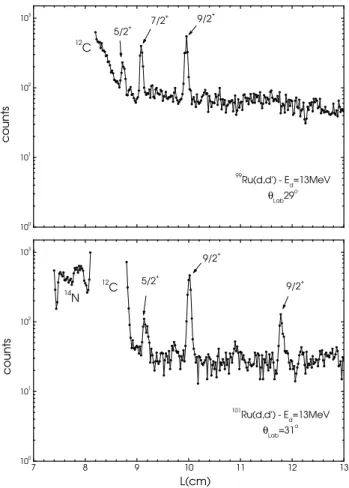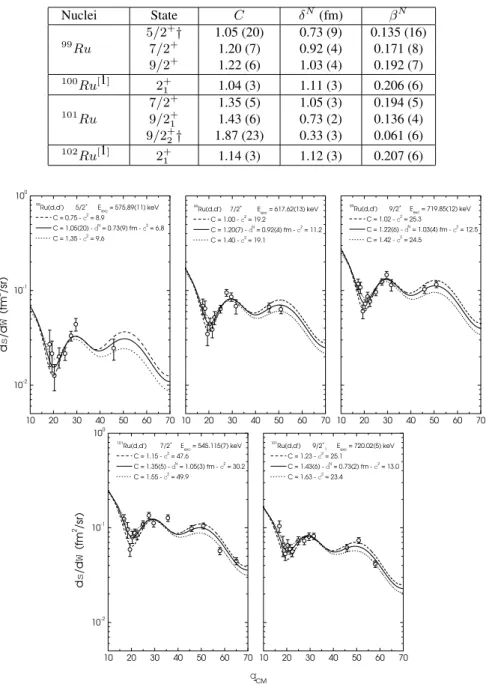760 Brazilian Journal of Physics, vol. 34, no. 3A, September, 2004
Coulomb-Nuclear Interference (CNI) Results of the Collective
Quadrupolar Excitations in Odd and Even Ru Isotopes
C. L. Rodrigues
1, M. R. D. Rodrigues
1, T. Borello-Lewin
1, L. B. Horodynski-Matsushigue
1,
J. L. M. Duarte
1, G. M. Ukita
1,2, and G. N. Hanninger
11Instituto de F´ısica, Universidade de S˜ao Paulo
Caixa Postal 66318, CEP 05389-970, S˜ao Paulo, SP, Brazil
2Faculdade de Psicologia, Universidade de Santo Amaro,
Rua Professor En´eas da Siqueira Neto, 340, CEP 04829-300, S˜ao Paulo, SP, Brazil
Received on 9 September, 2003
The study of the odd99,101Runuclei complements the investigation of the collectivity of the first quadrupolar excitations in100,102,104Ru. Angular distributions for the99,101Ru(d, d′)reactions at 13 MeV were obtained in
the Pelletron Laboratory using nuclear emulsion plates on the focal plane of the Enge spectrograph. A Coulomb-Nuclar Interference analysis employing DWBA-DOMP predictions with global optical potential parameters was applied to the excitation of states which could belong to the multiplet built on the first quadrupolar excitation of the core. In the analysis, three states were identified for each of the isotopes and associated, respectively, with adopted levels in the Nuclear Data Sheets Compilation ofJπ = 5/2+
,7/2+ and9/2+. Through the comparison of experimental and predicted cross section angular distributions, the values of(δN
L)2and of the ratioC=δC
L/δNL were obtained.
1
Introduction
The S˜ao Paulo Nuclear Spectroscopy with Light Ions Group, employing the Pelletron-Magnetic-Spectrograph system, has contributed to the experimental study of the complicated region ofA ∼100with the investigation of the Coulomb-Nuclear interference (CNI) on even nuclei [1, 2], in the in-elastic scattering of isoscalar projectiles (deuterons,alphas and lithium).
The present study of the odd 99,101Runuclei comple-ments the survey of the collectivity of the first quadrupolar excitations in 100,102,104Ru [1], allowing for the simulta-neous extraction of the square of mass deformation length ((δN
L)2), obtained through the scale factor from the fit of
pre-dictions of the distorted wave Born approximation (DWBA), within the deformed optical model potential (DOMP), to the experimental data, and of the ratioC = δC
L/δLN, extracted
through of the analysis of the angular distribution shape. Since the cross sections of inelastic scattering on odd nu-clei are much smaller than the corresponding ones on even nuclei, due to the fragmentation of the multipolar excita-tions, there are relatively less studies on odd targets. In particular, no previous study of the odd ruthenium isotopes is available, although one theoretical interpretation [3] of 99Ru, linking it to its even neighbour, had aroused an in-teresting question about the magnitude of the quadrupolar deformation length, therein predicted to be much smaller for the odd isotope.
2
Experimental Procedure
Data for the 99Ru(d, d′) and 101Ru(d, d′) reactions at
13 MeV were obtained in the Pelletron Laboratory, with the beam trimmed to produce a conveniently small object on the 99Ruand101Rutargets (97%enriched).
The products of each reaction were momentum analysed by the Enge split-pole spectrograph and detected in nuclear emulsion plates, positioned on the focal plane of the spec-trograph. Thirteen and sixteen inelastic scattering spectra, respectivily for99Ruand101Ru, with an energy resolution between 6 keV and 12 keV, were measured in the angular range of16.5◦ ≤θ
lab ≤64◦. The use of nuclear emulsion
and the good energy resolution of the experimental facili-ties were essential to achieve the aims of this study. Fig. 1 displays part of one spectrum for each reaction.
Through the comparison of the elastic scattering experi-mental angular distribution (taken at five angles between30◦
and70◦for each target) with optical model predictions, the
normalization of the data was obtained.
3
Analysis
In the analysis, three states were identified and associated, respectively, with adopted levels in the Nuclear Data Sheets Compilation [4, 5] of Jπ = 5/2+, 7/2+ and9/2+. The parametersCandδN
L have been extracted in the
C.L. Rodrigueset al. 761
100 101 102 103
7 8 9 10 11 12 13
100 101 102 103
12 C
9/2+
5/2+
7/2+
99
Ru(d,d') - Ed=13MeV
θLab29 o
c
o
u
n
ts
14 N
12
C 9/2+
9/2+
5/2+
L(cm)
101
Ru(d,d') - Ed=13MeV
θLab=31 o
c
o
u
n
ts
Figure 1. Parts of deuteron spectra from the 99Ru(d, d′) and
101Ru(d, d′)reactions at 29◦and 31◦, respectively. Peaks
cor-responding to states of99Ruand101Ruare identified. The7/2+
of101Ruis hindered by the peak associated with the elastic scat-tering by12C.
and101Ru, could be members of the multiplet built on the first quadrupolar excitation of the core coupled to thed5/2 particle.
The analyses of the multiplet states associated with the first quadrupolar excitation in 99,101Ru were done through the comparison of the experimental angular dis-tributions with DWBA-DOMP predictions employing the DWUCK4 [6] code and the global deuteron optical potential parameters of Perey & Perey [7], with the usual correction for nonlocality effects. The relation between the experimen-tal results and the DWBA-DOMP description of the cross section is written as:
σexp(θ) =α2σDW
L (θ, C),
withC = δ′C
L /δL′N = δLC/δNL andδ′LN proportional toα,
where (δLC) and (δNL) are the charge and mass deformation
lengths, respectively. The usual deformation length param-eterδN
L is related toδ′LN through: δ′N
L =
q
(2Jf+1)
(2Ji+1)(2L+1)δ
N
L,
whereJiandJf are the spins of the initial and final states.
The fits of the experimental angular distributions are per-formed by aχ2minimization procedure, using the iterative method of Gauss [8], sinceCandδ′N
L are correlated.
4
Results and Comments
Figure 2 shows the predicted angular distributions, fitted to the experimental data, as well as two other curves, with a variation around the fitted C value. The sensibility of the method is, thus, illustrated.
The results obtained for the more strongly excited7/2+ and9/2+states are compared with information given in the literature for some of the even nuclei in the chain of Ru, as shown in Table I. The less intense5/2+excitations are still under analysis and upper limits for the other states which could belong to the multiplet [3] are also being investigated. Table I shows that in the odd nuclei the contribution of the protons to the excitations of interest is considerably higher than that of the neutrons, in comparison with the ho-mogeneous collective model, which predictsC = 1for the contributions in the ratioZ/N. The analysis also points to a mass deformation length associated with the quadrupolar excitation in the odd isotopes at the same level as those ex-perimentally determined for either100Ruor102Ru[1], but much higher than that employed in the theoretical descrip-tion of99Ru[3].
The one particle-rotor model calculations [3], had to re-sort to a deformation length reduced by about a factor of two with respect to the even neighbour. The7/2+and9/2+ states in99Ruand7/2+in101Ruseem to follow the usual statistical(2Jf+1)factor in the excitation of the multiplets,
but the9/2+excitation in101Ruis appreciably weaker than would be predicted by a simple weak coupling model. In fact, as shown in Fig.1, the intensity of this state is frag-mented to another9/2+state of101Ru, at 928.77(5) keV.
Also shown in Table I are preliminary results associated with this second9/2+ state detected in 101Ru. The sum of the deformation lengths for both9/2+states reaches the same value, considering the uncertainties, of the deforma-tion length extracted for the7/2+. In the last column of the table the correspondent parameters using the reduced mass radius of 1.16 fm are indicated for a easier comparison with information of the literature for other nuclei.
Acknowledgments
762 Brazilian Journal of Physics, vol. 34, no. 3A, September, 2004
TABLE I: ParametersC,δN andβN
extracted in the present work for99,101Ruand compared with their even neighbours. Only statistical uncertainties are shown and preliminary analysis are indicated by†.
Nuclei State C δN
(fm) βN
5/2+† 1.05 (20) 0.73 (9) 0.135 (16) 99Ru 7/2+
1.20 (7) 0.92 (4) 0.171 (8)
9/2+ 1.22 (6) 1.03 (4) 0.192 (7) 100Ru[1] 2+
1 1.04 (3) 1.11 (3) 0.206 (6)
7/2+ 1.35 (5) 1.05 (3) 0.194 (5)
101Ru 9/2+
1 1.43 (6) 0.73 (2) 0.136 (4)
9/2+2† 1.87 (23) 0.33 (3) 0.061 (6)
102Ru[1] 2+
1 1.14 (3) 1.12 (3) 0.207 (6)
10 20 30 40 50 60 70
10-2 10-1 100
10 20 30 40 50 60 70 10 20 30 40 50 60 70
10 20 30 40 50 60 70
10-2 10-1 100
10 20 30 40 50 60 70
99 Ru(d,d') 5/2+
Eexc = 575,89(11) keV C = 0,75 - c2
= 8,9 C = 1,05(20) - dN
= 0.73(9) fm - c2 = 6,8 C = 1,35 - c2 = 9,6
d
s
/d
W
(f
m
2 /sr)
99 Ru(d,d') 7/2+
Eexc = 617.62(13) keV C = 1.00 - c2 = 19.2
C = 1.20(7) - dN = 0.92(4) fm - c2
= 11.2 C = 1.40 - c2 = 19.1
99 Ru(d,d') 9/2+
Eexc = 719.85(12) keV C = 1.02 - c2
= 25.3
C = 1.22(6) - dN = 1.03(4) fm - c2 = 12.5 C = 1.42 - c2
= 24.5
q CM
d
s
/d
W
(f
m
2 /sr)
101 Ru(d,d') 7/2+
Eexc = 545.115(7) keV C = 1.15 - c2 = 47.6
C = 1.35(5) - dN = 1.05(3) fm - c2
= 30.2 C = 1.55 - c2
= 49.9
101 Ru(d,d') 9/2+
1 Eexc = 720.02(5) keV C = 1.23 - c2 = 25.1
C = 1.43(6) - dN = 0.73(2) fm - c2
= 13.0 C = 1.63 - c2
= 23.4
Figure 2. Experimental angular distributions for states associated with the first quadrupolar excitation in99Ruand101Ru. The solid line corresponds to the DWBA-DOMP best fit.
References
[1] L. C. Gomes et al., Phys. Rev. C54, 2296 (1996).
[2] G. M. Ukita, T. Borello-Lewin, L. B. Horodynski-Matsushigue, J. L. M. Duarte, and L. C. Gomes, Phys. Rev. C64, 014316 (2001).
[3] C. S. Whisnant et al, Phys. Rev. C34, 443 (1986). [4] B. Singh, Nuclear Data Sheets, 81, 1 (1997). [5] J. Blachot, Nuclear Data Sheets, 83, 1 (1998).
[6] P. D. Kunz, computer code DWUCK4, University of Col-orado, 1974.
[7] C. M. Perey and F. G. Perey, At. Data and Nucl. Data Tables 17, 1 (1976).

